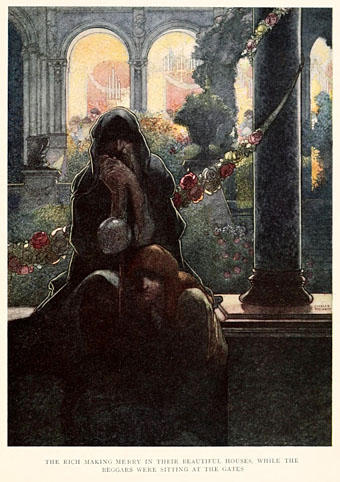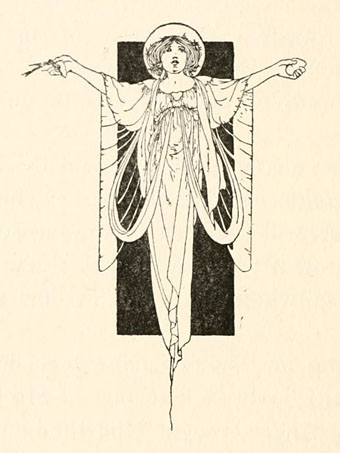“The rich making merry in their beautiful houses, while the beggars were sitting at the gates.” Above and below: illustrations by Charles Robinson from The Happy Prince and Other Tales, an edition from 1920.
Continuing an occasional series. I’ve yet to see a copy of the recent annotated and unexpurgated edition of The Picture of Dorian Gray but Alex Ross wrote a marvellous essay for the New Yorker about the novel, its creation, its public reception, and Wilde’s decision to tone down the overt homoeroticism of its earlier drafts. This is one of the best pieces I’ve seen for a while about Wilde, replete with choice detail:
The gay strain in Wilde’s work is part of a larger war on convention. In the 1889 story “The Portrait of Mr. W. H.,” a pseudo-scholarly, metafictional investigation of Shakespeare’s sonnets to a boy, Wilde slyly suggests that the pillar of British literature was something other than an ordinary family man. In the 1891 play “Salomé,” Wilde expands a Biblical anecdote into a sumptuous panorama of decadence. Anarchists of the fin de siècle, especially in Germany, considered Wilde one of their own: Gustav Landauer hailed Wilde as the English Nietzsche. Thomas Mann expanded on the analogy, observing that various lines of Wilde might have come from Nietzsche (“There is no reality in things apart from their experiences”) and that various lines of Nietzsche might have come from Wilde (“We are basically inclined to maintain that the falsest judgments are the most indispensable to us”). Nietzsche and Wilde were, in Mann’s view, “rebels in the name of beauty.”
As for the novel, I’m feeling rather Dorian Grayed-out at the moment, having recently completed ten illustrations based on the story for a forthcoming anthology. More about that later.
Elsewhere, the William Andrews Clarke Memorial Library in Los Angeles has been running an exhibition, Oscar Wilde & the Visual Art(ists) of the Fin-de-Siecle, since July, and will continue to do so until the end of September. No word about what’s on display but this page on their website has details of their collection of Wilde materials which they say is the most comprehensive in the world.
Finally, the majority of visits to these pages in recent days have come from this post about Ivan Albright’s astonishing Dorian Gray painting in the Art Institute of Chicago. The post links to an earlier one of mine about the paintings used in Albert Lewin’s 1945 film of the book.
Elsewhere on { feuilleton }
• The Oscar Wilde archive



We got the unexpurgated/annotated version at work not that long ago. There’s a good reproduction Ivan Albright’s painting in it.
What’s the difference between unexpurgated and uncensored?
Browsing through it now. Other reproductions in it include the front cover of Lippincott’s July 1890, occupies its first 100 pages, front cover of the 1891 book edition, calling card left by Marquis of Queensbury (handwriting so bad ‘posing’ looks like ‘Jothsoh’), front cover of A Rebous 1884, also a few illustrations by SA Moss from the Sunflower Edition of the Works of Oscar Wilde. A theatre program for the first theatrical adaptation 1913. Book is square shaped instead of the normal rectangular shape books have. Lots of other contemporary illustrations as well
I suppose expurgation is more of an editing job done with some author approval as opposed to censorship which isn’t.
I wondered about the format since all the pictures of the book showed it to be square. That’s an odd coincidence since I’ve used a square shape as a linking device in my illustrations. As for the pictures, I have a few books of Wilde ephemera which contain most of that material.
Ooooh, I’m just dying to see your Dorian Gray work!!!
I love Albright’s paintings, and being a Chicagoan have spent some time looking at them up close.
Gabriel’s comment reminds me that whenever I see mention of the Marquis of Queensbury, the word “somdomite” always comes to mind…
PS Check the close ups of the portraits face toward the end of this post http://www.dvdbeaver.com/film2/dvdreviews29/picture_of_dorian_gray.htm
PPS Any idea where he came up with the actual name “Dorian Gray” ?
http://www.doriangray.net/dorian-gray-in-images.php
Those colour scans look better than I’ve ever seen them before.
Dorian Gray’s name is one of my favourite aspects of the book, being a perfect amalgam of several things: an allusion to John Gray, a young poet with whom Wilde was briefly infatuated before he met Alfred Douglas, the Dorians of Ancient Greece (Wilde almost always referred to same-sex love in a Greek context), and grey being a neutral tone between black and white which points to Dorian’s ambivalent morality and sexuality.
Am v exited about your version of Dorian Gray. Will we be seeing the actual portrait? It must be quite difficult to come up with something when there’s a ‘definitive’ version from the film…
You could always use the one from the ‘League of Extrodinary Gentlemen’ film for reference.. ’cause that was rilly kool dude.
Thanks, I’m actually hoping people won’t be disappointed since I feel I could have done more with the story. I ran out of time despite having ages to prepare, too much pressure from other work.
Yes, there’s two pictures of the portrait, a before and after. The before is something of a cheat but I’ll explain why when I post the pictures. It’s also impossible to improve on Ivan Albright’s picture which raises a different set of problems.